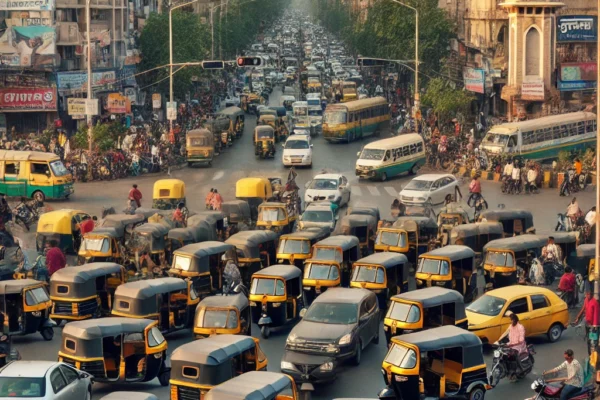Nagpur: The worsening menace of auto-rickshaws in the Second Capital of Maharashtra has reached a breaking point. Despite the presence of 317 designated auto stands across Nagpur, three-wheeler drivers continue to defy traffic norms, occupying roads, footpaths, and crucial intersections. This blatant encroachment has turned major areas such as Variety Square, Rani Jhansi Square, Munje Chowk, LIC Square, and the railway station gates into congestion hotspots, causing severe inconvenience to commuters and pedestrians alike.
According to records from the Regional Transport Office (RTO) in both the East and City Offices, Nagpur is home to a staggering 44,881 registered auto-rickshaws authorized for passenger transport. However, only a minuscule fraction utilizes the designated stands, resulting in widespread road encroachment and traffic bottlenecks.
Enforcement falls short
In 2024 alone, the Nagpur Traffic Police took stringent action, issuing 34,608 challans against rogue auto drivers and collecting an astronomical Rs 2.44 crore in fines. Notably, 10,512 private autos were fined Rs 71.85 lakh, while 24,096 public autos were penalized Rs 1.72 crore for violations under the Motor Vehicles Act. Yet, despite these hefty fines, errant drivers persist with illegal parking, wrong-side driving, and overcrowding of passengers, making daily commuting a nightmare.
Despite 317 designated auto stands capable of accommodating only 2,795 autos, the city is swamped with a vastly higher number of rickshaws. Region-wise statistics highlight the glaring disparity:
• North Nagpur: 58 stands for 519 autos
• West Nagpur: 65 stands for 560 autos
• East Nagpur: 52 stands for 417 autos
• Indora: 49 stands for 473 autos
• South Nagpur: 44 stands for 456 autos
• MIDC: 49 stands for 370 autos
With an overwhelming 44,881 autos competing for limited space, rampant violations are inevitable.
Unruly drivers bring city to a standstill
Instead of using designated stands, auto drivers prefer to stop arbitrarily, particularly in commercial areas, outside hospitals, and near educational institutions, further worsening congestion. Variety Square and Rani Jhansi Square are among the worst affected, with haphazardly parked autos blocking both vehicular and pedestrian movement. At Munje Chowk, already plagued by street vendor encroachments, the illegal parking of autos has exacerbated traffic snarls. Similarly, LIC Square and Nagpur Railway Station remain perennially clogged, with passengers forced to navigate dangerously congested roads due to autos blocking footpaths and entry points.
Despite repeated crackdowns, the menace persists. Many auto drivers exploit regulatory loopholes or bribe officials to escape stricter penalties. While police frequently tow illegally parked vehicles, these measures have failed to bring lasting relief. Commuters frequently complain about drivers refusing to use designated stands, overcharging fares, declining short-distance rides, and stopping abruptly in the middle of the road to pick up passengers, creating hazardous conditions.
The urgent need for reform
Experts argue that immediate and stringent interventions are required to curb this growing menace. Proposed solutions include:
• Digitized allocation system for auto stands to ensure efficient parking and fair distribution of spaces.
• Steeper fines and impounding of repeat offenders’ vehicles to deter non-compliance.
• Establishment of no-auto zones in high-traffic areas to ensure smoother traffic flow.
• Expansion of public transport services, including electric buses, to reduce dependency on auto-rickshaws.
Without decisive and consistent action from authorities, Nagpur’s roads will continue to be held hostage by unruly auto-rickshaw drivers, leaving citizens trapped in relentless traffic chaos. The time for stronger enforcement is now, or the city’s traffic woes will spiral further out of control.

















